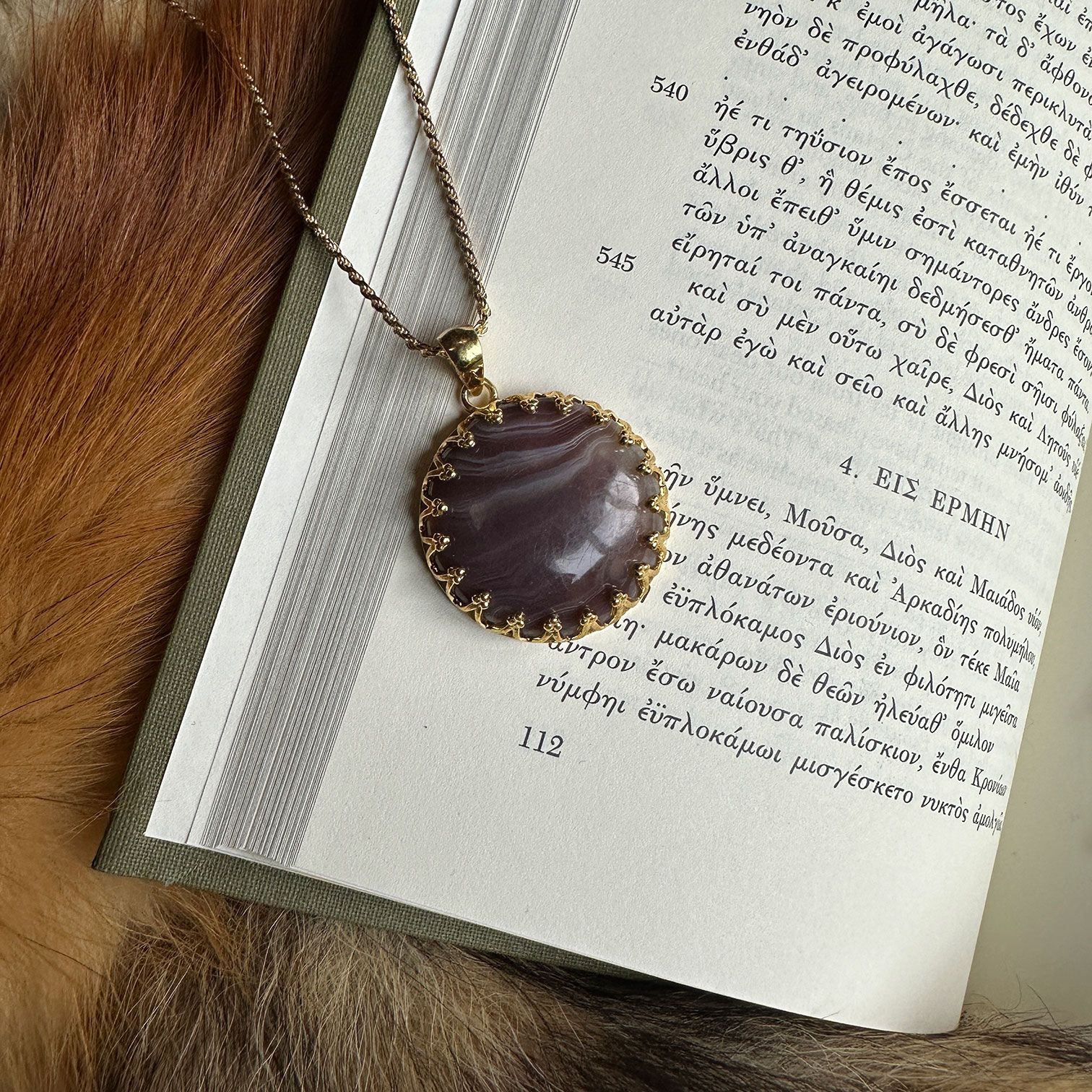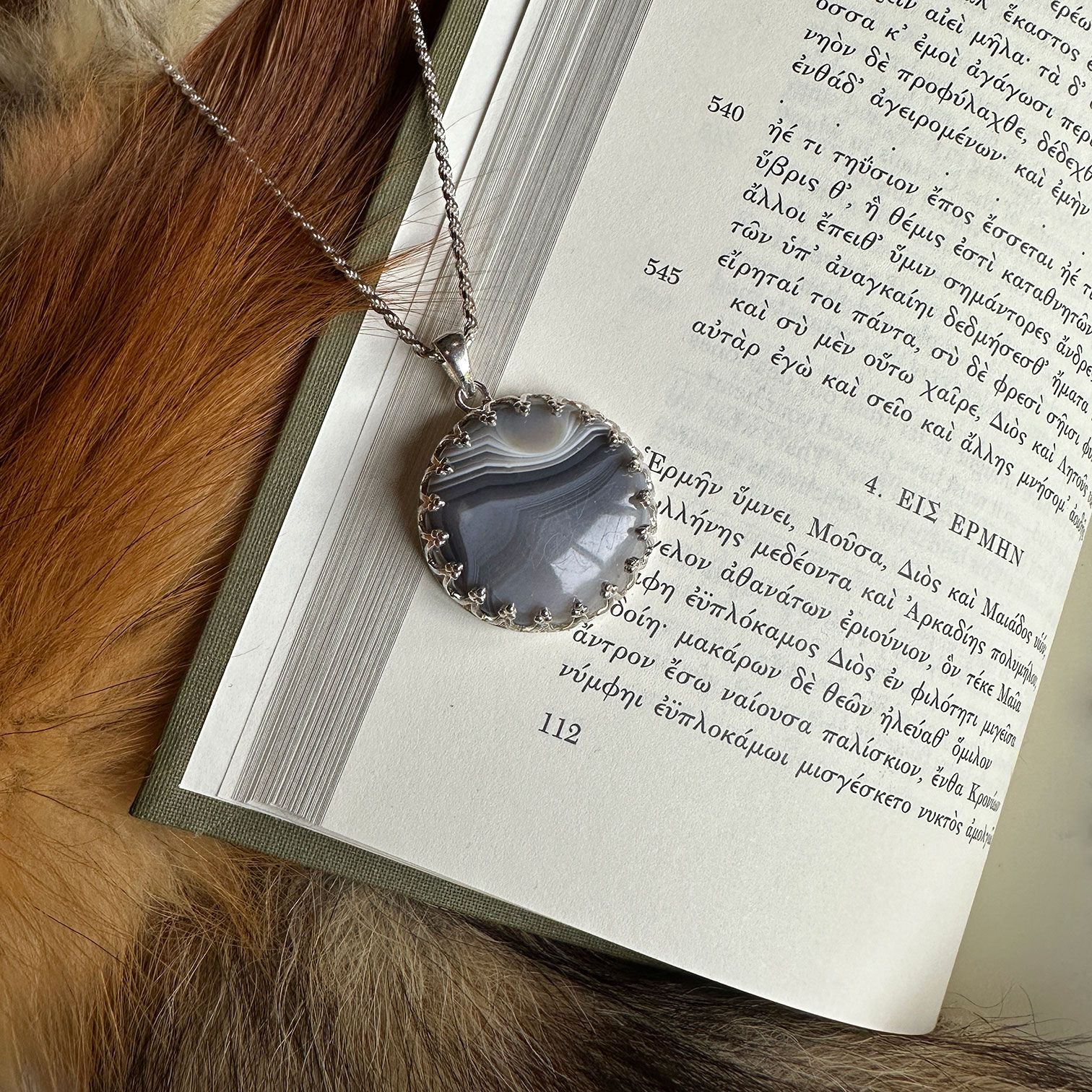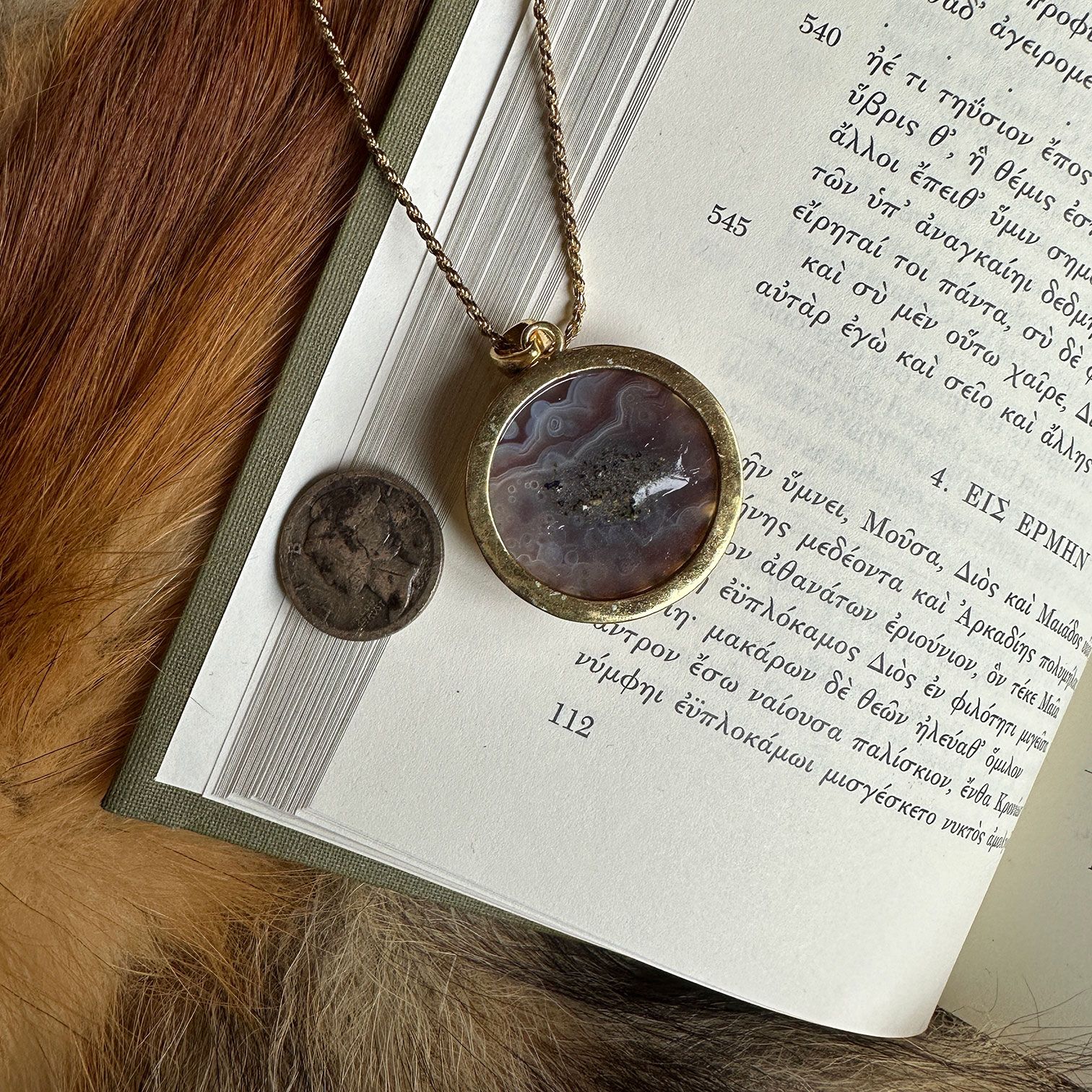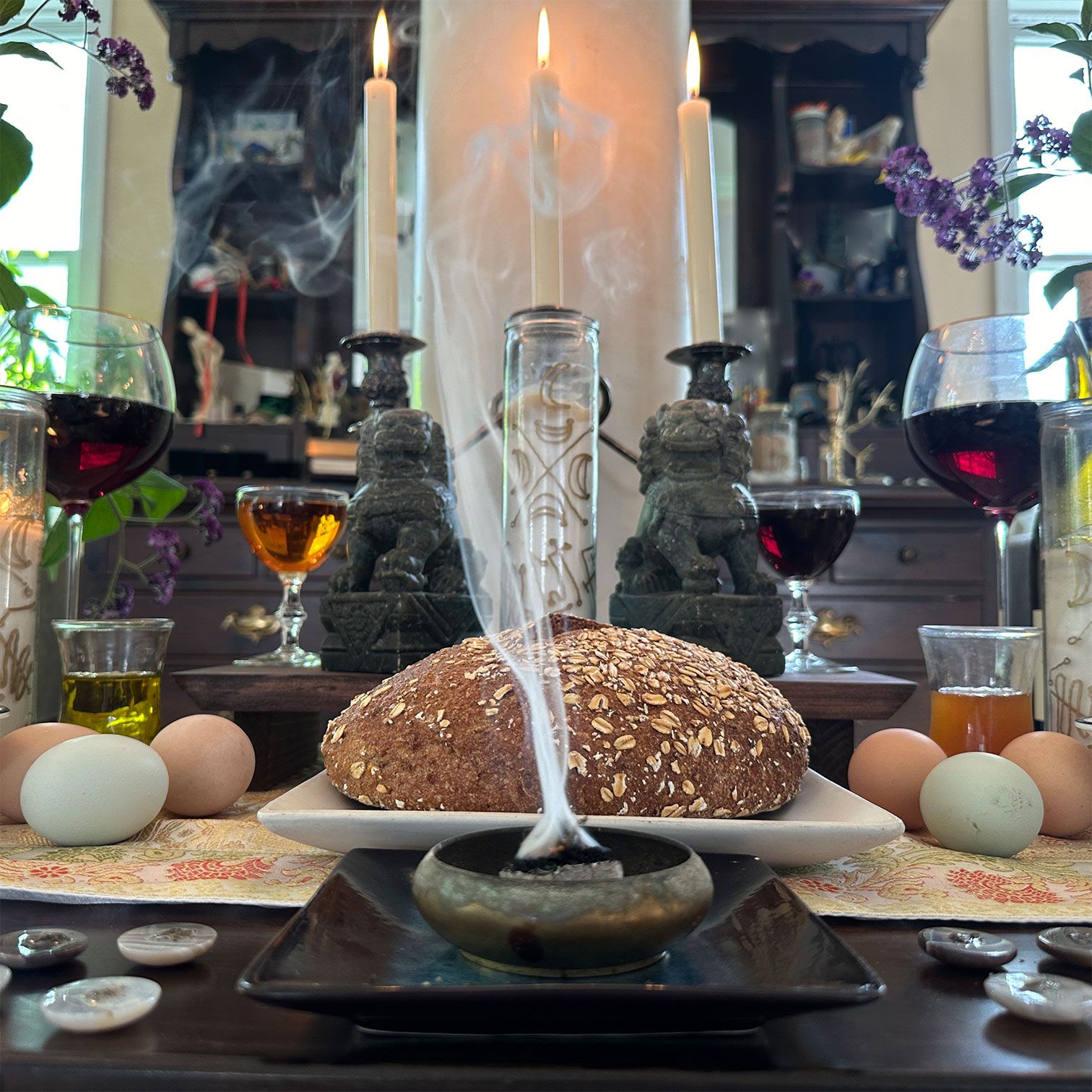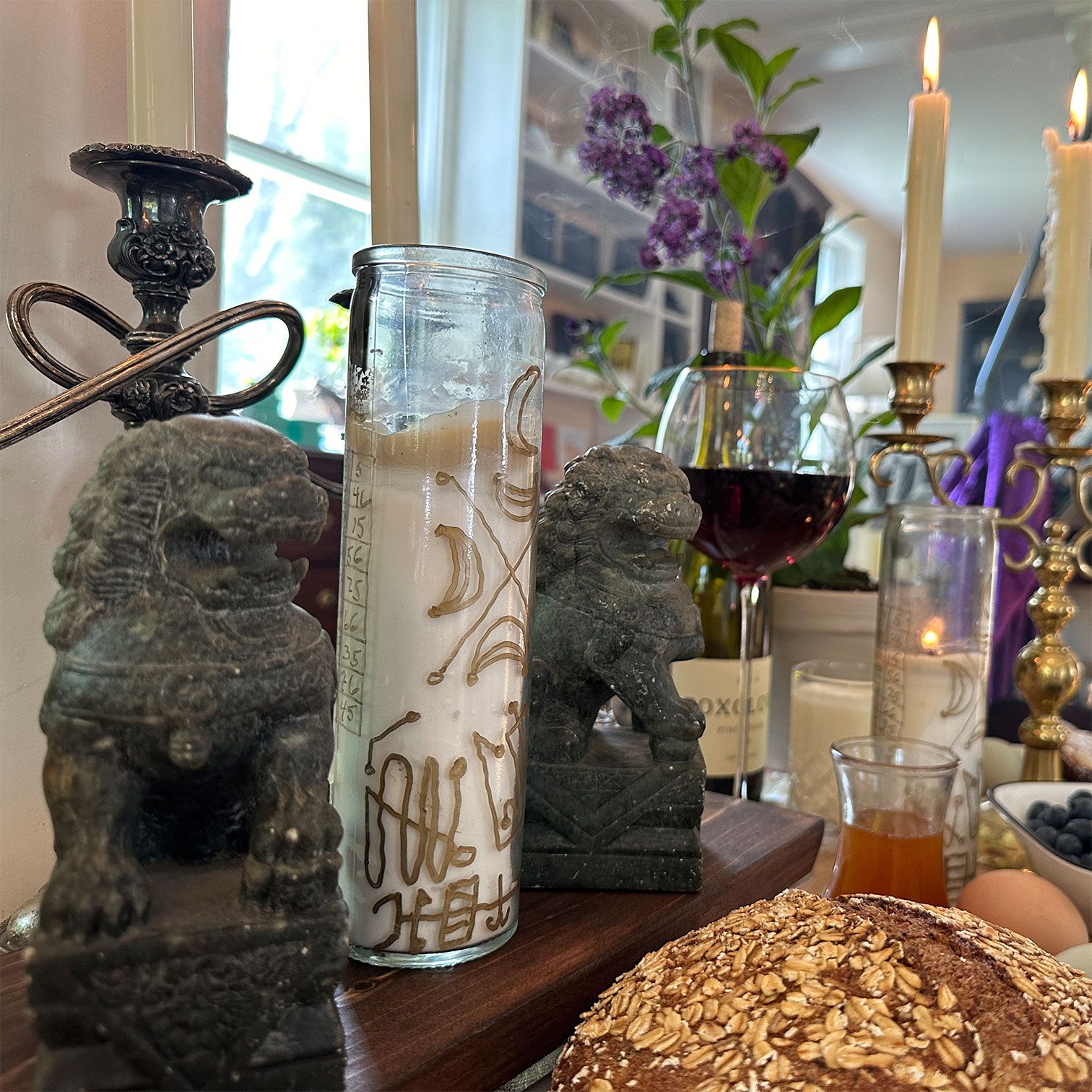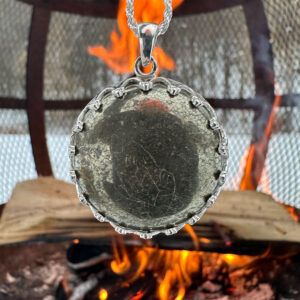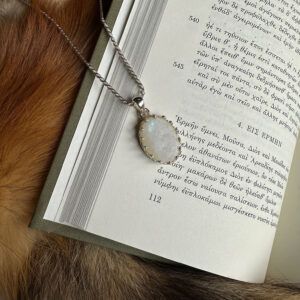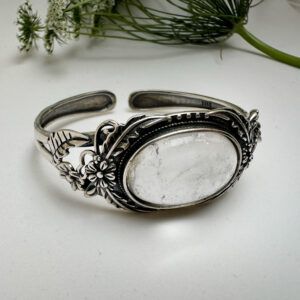Description
Of the nature of the fixed star Procyon, these Botswana agate pendant talismans were created with the intent of granting the range of Procyon’s blessings: favor from gods, humans, and spirits, influence over spirits of the air, preservation of health, and protection against magic and witchcraft.
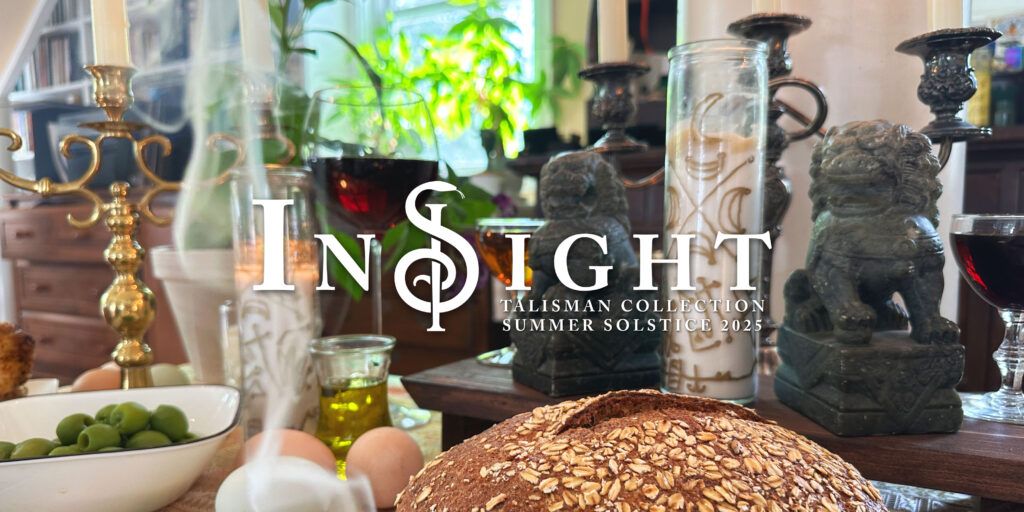
Procyon means “coming before the dog” in ancient Greek, capturing how Procyon rises before Sirius, the Dog Star. Greek myth narrates this observational ensemble as Laelaps, the magical dog that catches everything it chases, running after the Teumessian Fox, a magical beast that can never be caught. To solve the paradox of impossibly clashing magical abilities, Zeus turned the creatures into stone and cast them into the sky, where we know them as stars of Canis Major (Sirius) and Canis Minor (Procyon).
As with many, perhaps most, fixed star talismans, the origins and rationale for the magical significations and talismanic properties of Procyon are shrouded in obscurity. Our most commonly available source text for fixed star talismans—the Liber de Quindecim Stellis and its many variants—comes to us via medieval Latin manuscripts purporting to be translations of an Arabic text attributed to Mashallah that was itself possibly a translation from earlier Greek sources, which, if not apocryphal, are now lost. Mages are thus left to cobble together piecemeal sources, speculations, and personal gnosis to make sense of these talismans.
De Quindecim Stellis (tr. Regulus Hess) provides two statements about the properties of Procyon talismans. Describing the ring of Procyon, we are told that it “keepeth a man in health” (p. 33), and in the section on stones, we are told that the stone of Procyon is agate, followed by a list of virtues: “to grant favor before God and man; it giveth a man influence over the spirits of the air, and imparted great power against magic” (p. 29). From these many qualities we have honed in on two core features: protection (against magic, and of health) and favor (from all manner of beings).
The protective, preservative qualities of Procyon talismans have a clear mythological connection to the association of Procyon with the Teumessian Fox, who cannot be caught by any hunter. The association of dogs with protection, however, is significantly more ancient, as explained by Christopher Faraone in his Talismans and Trojan Horses (pp. 22-23):
“Monumental stone dogs begin to appear in Egypt in the eighth century B.C., and in Achaemenid Persia in the mid sixth century. Pairs of dog statues are attested in archaic Greece in the late sixth century where they appear to have been stationed as guardians of public places and tombs. Although there are no surviving examples of monumental dog figures in Mesopotamia, literary evidence points to their use in pairs at the threshold during the Neo-Assyrian period along with the other figures mentioned previously… There is, moreover, abundant testimony to the use of smaller statuettes of dogs in special rituals to protect the doors and gateways in the ancient Near East. A Hittite cuneiform ritual tablet prescribes the placement of a figurine on the royal threshold at night to drive away a nocturnal demon of some sort…”
In addition to these symbolic associations with Near Eastern apotropaic statues and Greek myth, Procyon talismans, like all fixed star talismans in De Quindecim Stellis, magnify the occult virtues of their associated stones: “Each of these [stones] ought to be polished and graven or inscribed when the Moon shall be joined with the star pertaining thereto; for when this should be so, their power will be increased a hundredfold” (tr. Regulus Hess, p. 27). Though nowadays agate is a fairly common and inexpensive stone, it was not always so. Its name derives from the name of the river Achates in Greece, the banks of which were the only known source of agate in antiquity. Its rarity and polychromatic appearance may partly explain the rich and extensive list of qualities assigned to agate. The lapidary poem of Bishop Marbode of Rennes extolled these virtues as follows (tr. C.W. King, quoted in Marbode of Rennes’ (1035-1123) De Lapidus, John M. Riddle, pp. 36-38):
“The Agate on the wearer strength bestows,
With ruddy health his fresh complexion glows;
Both eloquence and grace are by it given,
He gains the favour both of earth and heaven:
Anchises’ son, by this attendant saved,
O’ercame all labours, every danger braved.
The weary wretch who in far exile pines,
Restored to home, with pristine honours shines.
It gifts the pleader with persuasive art
To move the court and touch the hearer’s heart:
Th’ exhausted frame with youthful vigour filled
Exults once more with love’s high rapture thrilled.
From this the bride full powerful aid may gain
To bind her spouse’s heart with triple chain.
Bourne in the mouth the virtues of the stone
And all its mighty works are quickly shewn.”
As to the character of the Guardian’s Favor talismans, we can note that there are many types of dogs: think border collie, rather than lapdog. Like any good working dog, they do best when they have a job, and can generate a happy, positive vibe when they have a task. Just as energy without an outlet can lead to pressure and tension, it can be prudent to set the Guardian’s Favor talisman to rest on an altar or other place of respectful storage when there’s no call for its gifts.
Corresponding to these ideas, ancient sources tell us that Procyon is “of the nature of Mercury and the complexion of Mars” (De Quindecim Stellis, tr. Regulus Hess; see also Ptolemy’s Tetrabiblos). The mix of Mercurial and Martial lends itself to a stimulating, almost caffeinated quality to these talismans. This energizing quality can be a boon when it is needed, and can even assist with burnout and related issues, such as the problems with focus, frustration, and aimlessness that can come from spreading ourselves too thin. Congruent with the foundational Mercurial nature of this star, they also seem to give a boost to cognition and executive functioning.
From our experience thus far, the Guardian’s Favor talismans perform as the ancient texts proclaim and more. The favor with gods, humans, and aerial spirits seems to manifest as a kind of luck or felicity, smoothing out social interactions, helping with problem-solving, and improving access to help and the ability to ask for it. They seem to have a general road-opening quality: favor tends to open doors, after all. What the source texts don’t attest to is that they just feel good, too, and seem to bring mirth and good will to the bearer.
We would be remiss not to highlight that the caffeinated energetic Mercury-Mars nature of Procyon can, like caffeine itself, be the wrong medicine at certain times or for certain people. Thus, we do caution extra discernment for folks who find themselves chronically keyed up or always anxious. Our experience has also been that the driven quality of the Guardian’s Favor talismans in conjunction with the road-opening quality can lead to intensity in the adjustment period. Clearing away barriers and opening up new avenues can be disruptive, after all.
Technical Details
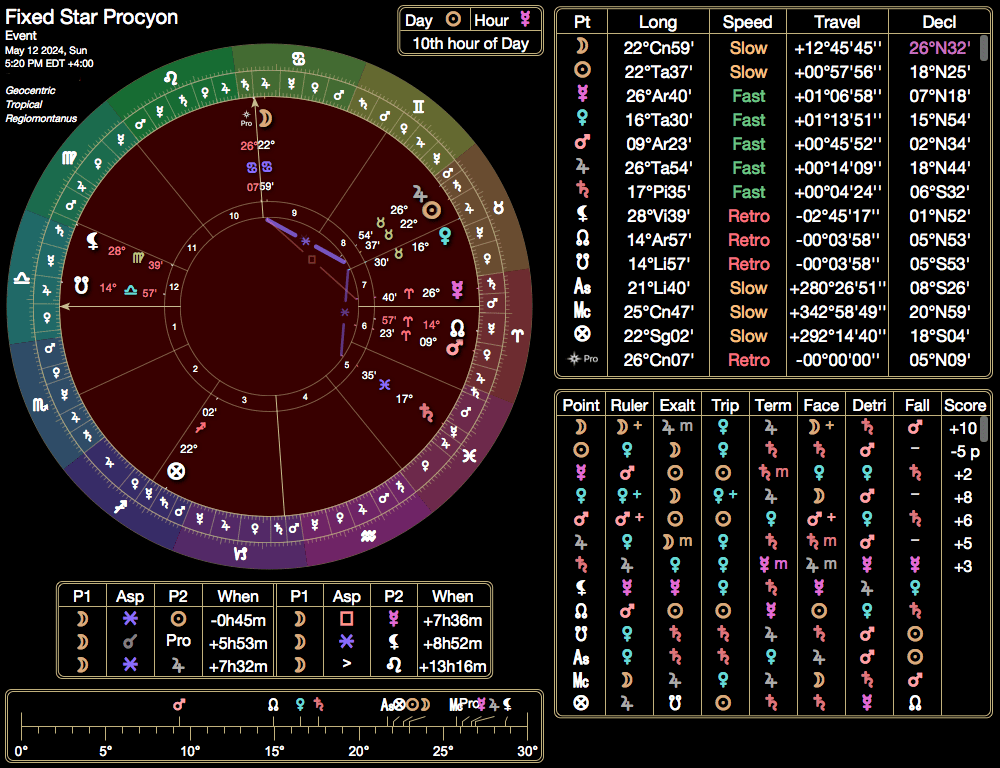
The fixed star Procyon talismans were ensouled on Sunday, May 12, 2024 between 5:13pm and 5:32pm EDT.
Essential Features of the Election
For fixed star astromagical elections, we require that the relevant fixed star either rises on the Ascendant or culminates on the Midheaven. In this election, fixed star Procyon was culminating on the Midheaven within 2°30’ on either side during the electional window.
Fixed star elections also require the Moon to be in sufficiently good condition and applying to the relevant fixed star. Idola Stellarum only uses lunar conjunctions to fixed stars. In this election, the first quarter Moon, dignified by rulership and face and increasing in light, was applying to conjoin Procyon within just over 3°. The Moon was separating from a sextile to the Sun, and applying by sextile to Jupiter in Taurus and by square to Mercury in Aries. The Moon was also long since separating from aspects to the malefic planets, Mars and Saturn.
Although we consider the condition of the Lord of the Ascendant to be a lesser factor in fixed star elections due to their austere nature and remoteness from the sublunary realm, we always examine the Ascendant Lord for all elections since the first house represents the bearer of the talisman. In this election, Venus, ruler of the rising sign of Libra, was dignified by rulership and triplicity in Taurus, and was copresent with the other two of the ‘Three Graces,’ the Sun and Jupiter.
Note that for fixed star talismans, planetary hour and day are not essential considerations. It was a nice bonus that this election took place during Mercury hour, as Procyon is of the nature of Mercury.
Further Magical Factors of the Election
In the main, this is a classic fixed star election: unafflicted Moon applying to the fixed star, Moon making a positive aspect to a benefic, and an Ascendant lord in good condition. The one issue, cited below, is the square aspect to Mercury. Since Procyon is “of the nature of Mercury and the complexion of Mars,” a square to Mercury in Aries could be read as embodying the qualities of Procyon—which, like the teeth of a dog, can be on the edgier side!
Reflection on Weaknesses of the Election
Two factor should be mentioned here. First, the Moon is on the slow side. Picatrix warns that the Moon should not be moving fewer than 12◦ per day. The Moon’s speed in this election was well above this threshold, but she would certainly not be considered moving fast in this chart.
Second, the square to Mercury could be seen as a minor affliction. Evaluating the Moon’s aspects to Mercury in astrological magic is a complex and delicate art (we go into the details in a post for Inner Sanctum members as part of our Aspects of the Moon minicourse). As Mercury’s condition was overall neutral in this election, the aspect of the Moon is not a major affliction, which it would have been if Mercury were, for instance, essentially debilitated or in applying aspect within orb to a malefic planet (Mercury’s next planetary aspect, other than to Moon, is a sextile to Saturn that will not complete for over 22°, well outside of the orb of application). As mentioned above, however, this aspect itself could be seen as ‘Procyonic,’ and the Moon’s in-orb applying aspect to Jupiter also softens the picture of these aspects somewhat. It’s also worth noting for completeness that Mercury is copresent with Mars in Aries, though widely separating by over 15°.
Ceremonial Details
Gemstone & Talismanic Image
The image chosen for the Guardian’s Favor talismans was one of the images cited in De Quindecim Stellis: “three maidens” (p. 38, tr. Regulus Hess). This image along with the name PROCYON were etched on the front of the stones, with the sigil of Procyon carved on the obverse side. According to De Quindecim Stellis, Procyon talismans “keepeth a man in health” (p. 33), and its virtue is also “to grant favor before God and man; [to] giveth a man influence over the spirits of the air, and imparteth great power against magic” (p. 29).
These many significations for this talisman stem from the abundance of virtues assigned to the agate in antiquity, when it was prized in part for its rarity (the name agate comes from the river Achates in Greece, the banks of which were the only known source of agate). The lapidary poem of Bishop Marbode of Rennes extolls these virtues as follows (tr. C.W. King, quoted in Marbode of Rennes’ (1035-1123) De Lapidus, John M. Riddle, pp. 36-38):
“The Agate on the wearer strength bestows,
With ruddy health his fresh complexion glows;
Both eloquence and grace are by it given,
He gains the favour both of earth and heaven:
Anchises’ son, by this attendant saved,
O’ercame all labours, every danger braved.
The weary wretch who in far exile pines,
Restored to home, with pristine honours shines.
It gifts the pleader with persuasive art
To move the court and touch the hearer’s heart:
Th’ exhausted frame with youthful vigour filled
Exults once more with love’s high rapture thrilled.
From this the bride full powerful aid may gain
To bind her spouse’s heart with triple chain.
Bourne in the mouth the virtues of the stone
And all its mighty works are quickly shewn.”
These significations echo and were likely sourced from the lapidary of Damigeron, which says, “He who wears [the agate] will be rich and powerful and pleasing and persuasive and be loved by God and man” as well as extolling medical virtues of the stone (The Virtues of STones, tr. Patricia Tahil, p. 30).
Ritual Setup

A working altar was erected to Procyon preceding the election, centered around two guardian dog statues. In addition to echoing the dog themes of Procyon’s identity as Canis Minor, these statues also symbolically reinforced the protective aspects of Procyon talismans. Dog statues have served an apotropaic function—that is, aversion of evil, protection from demonic forces and harmful magic—since the period of classical antiquity in the Near East and Greece:
“Monumental stone dogs begin to appear in Egypt in the eighth century B.C., and in Achaemenid Persia in the mid sixth cenruty. Pairs of dogstatues are attested in archaic Greece in the late sixth century where they appear to have been stationed as guardians of public places and tombs. Although there are no surviving examples of monumental dog figures in Mesopotamia, literary evidence points to their use in pairs at the threshold during the Neo-Assyrian period… There is, moreover, abundant testimony to the use of smaller statuettes of dogs in special rituals to protect the doors and gateways in the ancient Near East.”
—Christopher Faraone, Talismans and Trojan Horses, pp. 22-23
Offerings were made of of wine, spirits, flame, fresh bread, honey, Greek olive oil, blueberries, eggs, butter, pastry, and a roast chicken (one of the attested images of Procyon is a rooster). Three candles of the Moon, ceremonially consecrate with her sigils and kamea, also adorned the altar to mark Luna’s importance in fixed star rites.
Suffumigation
The suffumigation of these talismans consisted of the herbs of Procyon, heliotrope and pennyroyal, combined with the fine incense resins of Greek gum mastic and the highest quality Sultan’s grade royal Hojari frankincense.

